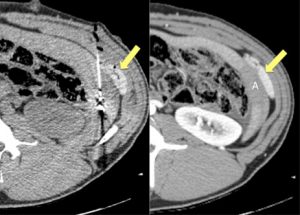In cases where access is difficult, or the ablation zone threatens nearby critical tissues, adjunctive techniques can be used to make percutaneous ablation more feasible. One such technique is hydrodissection: injecting a fluid or gel material to physically separate and protect non-target tissues.

Hydrodissection Gel Materials

Despite clinical success in using both D5W and normal saline for hydrodissection, the migration and rapid absorption of such fluids degrades the protective barrier. We are developing new materials for hydrodissection that can be injected through small-diameter needles (18-gauge or smaller) and become viscous inside the body. Such materials do not change the hydrodissection workflow — they actually reduce the amount of material needed by as much as 90% — and they offer the same protective benefits as D5W. In addition, they minimize barrier deformation and absorption, resulting in a more stable and effective barrier. This project began as a collaboration with the BME Design program at UW-Madison.